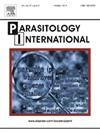淡水壶腹类蜗牛消化腺组织中某些遗传寄生虫幼虫变态作用的评价(Olivier, 1804)
IF 1.5
4区 医学
Q3 PARASITOLOGY
引用次数: 0
摘要
壶腹蜗牛(Lanistes carinatus)感染了两种地沟寄生虫的幼虫期,其中一种属于棘足虫属,另一种属于Phaneropsolus属。第一属为裸头尾蚴型,另一属为剑尾尾蚴型。后者尾蚴在口腔吸盘处有剑状棘,前者尾蚴在口腔吸盘上有棘。当检查蜗牛的消化腺时,这是两种寄生虫生长和变态的存在。对幼虫期感染的消化腺的组织学研究表明,棘球绦虫幼虫的发育过程从孢子囊到母孢子囊再到媒介,最后变成裸子尾蚴。在棘球绦虫属的幼虫发育过程中,棘球绦虫似乎只经历了孢子期的幼虫转化,然后才进入棘球绦虫型的尾蚴期。对受影响的消化腺组织的组织病理学研究表明,幼虫期的存在对消化腺细胞的影响是严重的和破坏性的。从观察来看,幼虫的机械和生理活动是受影响腺体组织正常结构发生重大变化的原因。因此,本研究追踪了任何寄生虫在任何宿主组织内引起的病理作用,但注意到它特有的指纹可以作为其存在的证据,而不是其他证据。本文章由计算机程序翻译,如有差异,请以英文原文为准。
Evaluation of the effect of larval metamorphosis of some digenetic parasites within the digestive gland tissues of the freshwater ampullariid snails, Lanistes carinatus (Olivier, 1804)
Ampullariid snail, Lanistes carinatus, was infected with larval stages of the two digenean parasites, one of which belonged to the genus Echinochasmus, and the other belonged to the genus Phaneropsolus. The first genus has gymnocephalus cercariae type, while the other has xiphidicercariae type. The later cercariae characterized with presence of xiphoid spine at oral sucker, while the first one has spines on its oral sucker. When examining the digestive gland of snails, it is the presence of growth and metamorphosis for both parasites. The histological study of the digestive gland infected with the larval stages showed that the larval development of Echinochasmus parasites progresses from sporocyst to mother sporocyst to the redia before it turns into gymnocephalus cercariae. As for the larval development of the genus Phaneropsolus, it appears to have undergone the larval transformation from the sporocyst stage only before reaching the cercaria stage of the type xiphidiocercaria. The histopathological study of the tissues of the affected digestive glands showed that the effect of the presence of the larval stages was severe and destructive to the cells of the glands. It appears from the observation that mechanical and physiological activity of the larvae was the cause of a major change in the normal structure of tissue of the affected glands. Therefore, the present study traces the pathological effect caused by any parasite within the tissues of any host, is noted, but a fingerprint specific to it that can be taken as evidence of its presence and no other.
求助全文
通过发布文献求助,成功后即可免费获取论文全文。
去求助
来源期刊

Parasitology International
医学-寄生虫学
CiteScore
4.00
自引率
10.50%
发文量
140
审稿时长
61 days
期刊介绍:
Parasitology International provides a medium for rapid, carefully reviewed publications in the field of human and animal parasitology. Original papers, rapid communications, and original case reports from all geographical areas and covering all parasitological disciplines, including structure, immunology, cell biology, biochemistry, molecular biology, and systematics, may be submitted. Reviews on recent developments are invited regularly, but suggestions in this respect are welcome. Letters to the Editor commenting on any aspect of the Journal are also welcome.
 求助内容:
求助内容: 应助结果提醒方式:
应助结果提醒方式:


